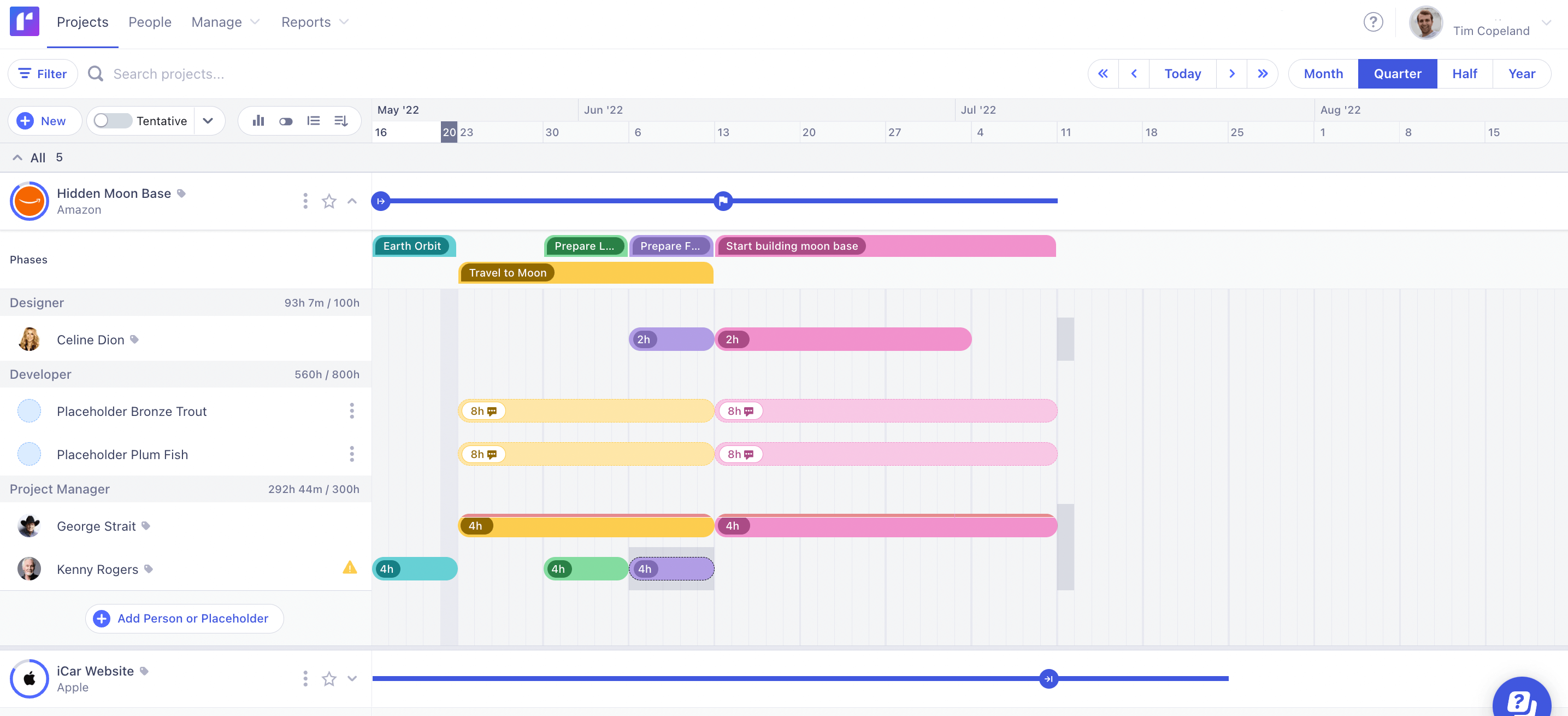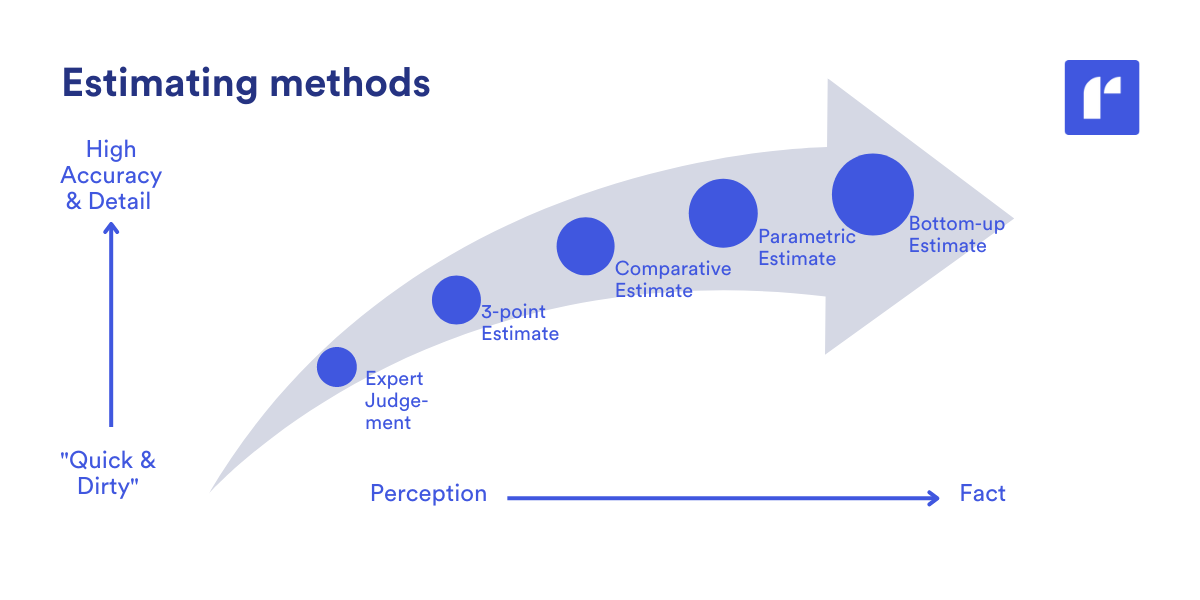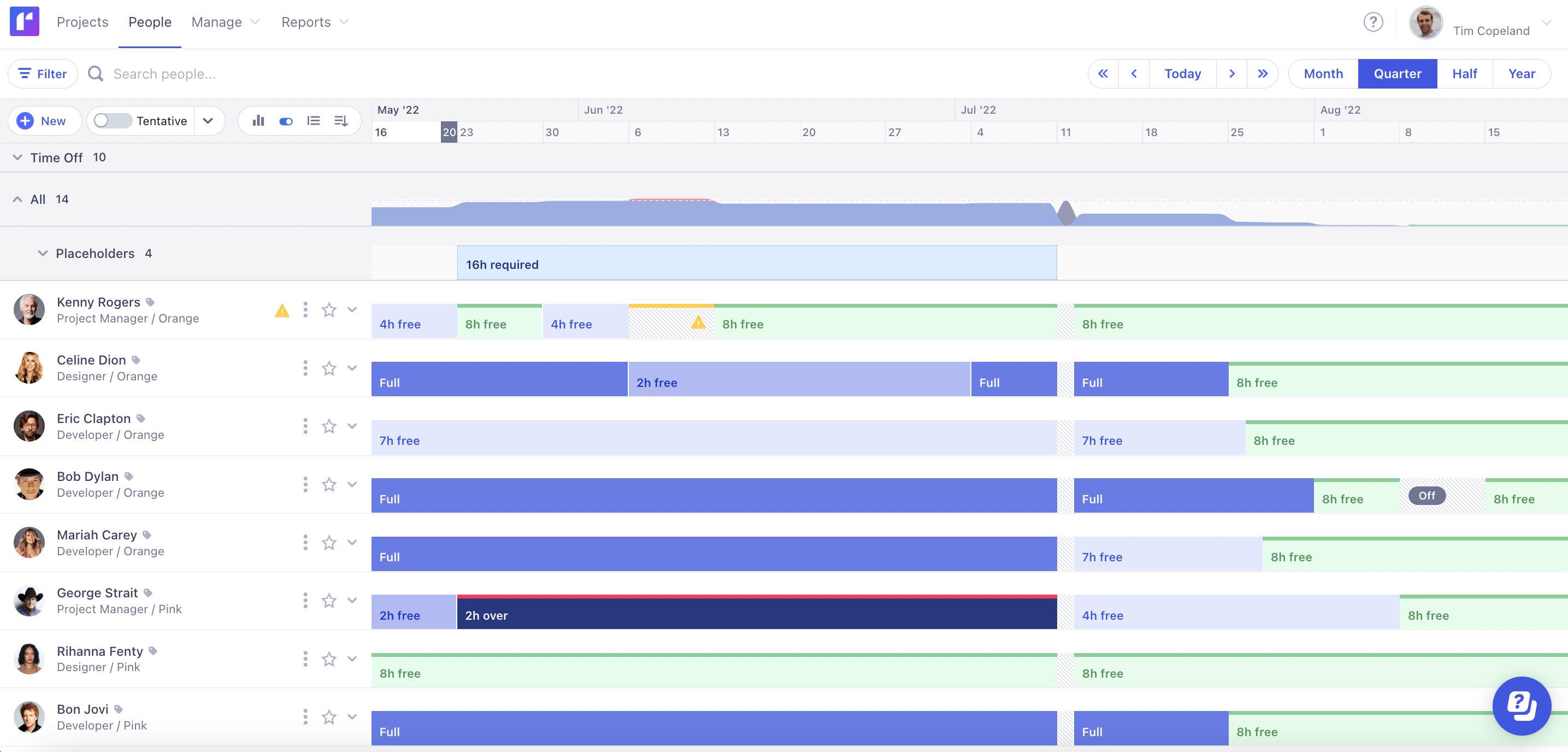Want to improve project outcomes? Optimize your project resources. Here’s how to leverage project resource management to deliver better projects.

Project resource management is about how you plan, manage, and optimize resources to deliver the best possible outcomes for your project and your people. It’s about intelligently aligning and assigning people to projects where they’re empowered to deliver their best work - engaged in tasks that suit and stimulate them, and never bored or burnt out.
By planning and managing your project resources effectively, you’re more likely to meet project milestones, stick to budget, and delight your clients. And it doesn’t have to be difficult. There are six stages to project resource management - defined by the Project Management Institute - and software tools to support you.
Here’s everything you need to know about managing project resources to maximize your project outcomes.
Project resource management describes the process of identifying, securing, and managing the resources you need to deliver a project successfully. It employs interconnected techniques to ensure a project meets its milestones - by intelligently applying the right resources to the right tasks at the right time.
The Project Management Institute breaks project resource management down into six steps.
We’ll explore each of these in more depth later. Jump there now if that’s what you’re here for!
A resource can be anything required to deliver a project successfully. It could be a physical resource - like specific materials or equipment. Or it could refer to human resources - the talented team members you need to deliver project outcomes.
Identifying, obtaining, monitoring and managing resources is fundamental to project management. Fail to identify or secure the resources you need and your project will be delayed or derailed. Whilst failure to monitor resources could result in a range of pricey problems - from overspend to underutilisation - which add unnecessary time and cost to your project.
Runn is all about people so - in this article - we’re talking about human resources. And how project resource management helps you create fulfilled, flexible, and fully optimized project teams. Because we believe that maximizing your people outcomes maximizes your project outcomes.
Project management is concerned with managing every element of a project to ensure it is a success - from people and processes to budget and schedule. It comprises a range of tools and techniques to ensure a project meets agreed objectives, timescale and cost.
Resource management is specifically concerned with managing resources within a business - such as materials, equipment, and people. It isn’t just concerned with a single project. It’s about ensuring the organization has the resources it needs to deliver all of its workstreams successfully. This includes forecasting needs, planning the allocation of resources, and ensuring they’re being utilized to the best effect. That is to say, your people are neither bored nor burnt out - they’re challenged, satisfied, engaged, and productive.
Sitting squarely between the two concepts is our topic - project resource management. This is resource management applied to an individual project. Like project management, it is concerned with delivering the project on time, on budget and to client satisfaction. And like resource management, it aims to ensure resources are optimally allocated and utilized.

Project resource management is beneficial because it lays the foundations for project success. It provides a structured framework to think through staffing implications and how you’ll optimize your human resources - so you and they can deliver the project to the best of your abilities, given the interdependencies and constraints you face.
Project resource management processes help you:

We're about to explore the six core project resource management processes. Before we do, it's important to know that a key output of this process will be your resource management plan.
A resource management plan documents how project resources should be allocated, managed, and released over the course of your project. It will contain key information about the project and its staffing including:
The Project Management Institute issues comprehensive guidance for project management professionals each year in a publication called Project Management Body of Knowledge - PMBOK for short. The information below summarizes their approach to project resource management.
[And, since one of the PMBOK recommendations is to leverage project resource management software to make the process easier, we’ve mapped their approach to some key functionality offered by Runn’s resource planning platform.]
It’s a good job project managers love planning as much as we do at Runn. Because this stage is about planning how you’re going to plan your resources! It establishes your approach to planning and managing resources based on the type and complexity of the project, as well as environmental and market factors.
For example, if your project has an easily manageable scope and is something you’ve done before, your approach to planning resources will look different to a project with a larger scope and less familiar parameters.
Furthermore, if you’re expecting to contract out any element of your project or make new hires, you need to be aware of the market. Will new talent be easy to secure or take additional effort? Will you be able to recruit at the right level of expertise or need to develop a more junior hire?
This stage is about establishing the resource requirements for the project - taking into account type, quantity and characteristics of the resources you need. Put simply, who do you need to perform the work, what skills do they need, and when do you need them?
Resource estimating techniques
There are a number of different estimating techniques you can use to work out how many resources you’ll need to deliver a particular project.

Selection criteria
When considering which resources you’d like access to, you should consider the following and rank your preferences according to how different individuals score.
Alternatives analysis
It’s also important to perform an alternatives analysis. There isn’t just a single pathway to project completion. It would be easier if there was! Projects are made up of lots of interchangeable elements, as well as interdependencies. An alternative analysis encourages you to come up with a Plan B - and beyond - and document the impact that would have on project KPIs. That way, you’re prepared to proceed with your project if certain resources are unavailable. And you have ammunition to help you fight for the resources you really want.
This stage is concerned with securing the resources you’ve identified for your project. As the project manager, you may not have control over the resources you require. This could be because of a matrix project environment, internal reporting relationships, or other reasons. And since demand almost always outstrips supply when it comes to resource availability, you need to be ready to negotiate!
Failure to acquire necessary resources can affect the project schedule, budget, and outcomes. Insufficient resources - or inadequate capabilities - reduce the likelihood of project success. So it’s important to make a strong business case for your cause. Your resource estimation, selection criteria, and alternatives analysis should be influential here.
Create a resource calendar
With your resources in place, it’s time to start resource scheduling and creating your resource calendar. This will help you plan a reliable overarching project schedule.
A resource calendar documents the time periods that each resource is needed for - and records any constraints on that time. For example time zones, work hours, vacation time, local holidays, and commitments to other projects.

This ensures you have a realistic picture of the time your resources actually have available for project work - you’re not about to be blindsided by an unexpected delay to your schedule.
Now you’ve secured your resources, you need to develop them into a coherent, collaborative and capable team, so you can ace your project objectives. Considerations at this stage include:
When your project is in motion, you’ll need to monitor and manage resource performance. It’s about keeping your team focused, on schedule, and set for success.
Emotional intelligence, leadership and influencing skills are essential here, as you may also need to address issues such as conflict between team members or underperformance. You may also have to manage changes to the project plan and adjust resource allocation accordingly. For example, a change of scope from the client, or having one of your team poached away by a high-priority project.
A key element of this stage is monitoring resource utilization - whether your team is being used to optimal capacity, how much of their time is billable and non-billable, and mapping planned vs actual utilization.

Failure to monitor resource utilization can result in overspending on staff time, or delays to your project schedule. Monitoring this data allows you to see if things are veering off-course and take corrective action before it’s too late.
➡️ Check our guide on how to build a resource utilization report here. 📖
This coincides with the ‘Manage’ stage. Where ‘Manage’ is related to human resources, ‘Control’ relates to physical resources. The same principles of monitoring and corrective action apply here too. Check five essential resource management reports here.
As an outstanding project manager, you’ll spend a lot of time monitoring and managing your team. Your people are the most important part of any project. It’s through their expertise and energy that your business delivers outcomes and delights your clients. So the time you spend managing and empowering those people is a sound investment.
But just because you expect to invest time in managing project resources, doesn’t mean you need to waste time doing it. One of the recommendations from the Project Management Institute is that project managers use appropriate software to make their jobs easier (and by doing a better job, make a positive impact on their projects).
Project resource management software provides access to real-time information about project resources, so that you can model, monitor and manage human resources more effectively - without having to wade through spreadsheets and potentially out-of-date project data.

Software like Runn puts the power in your hands. With our People Planner, you can see who is and isn’t available, what their skills are, whether they’re needed elsewhere. You have a complete view of how people are deployed, as well as the risk of interdependencies, changing timelines, illness or overload.
Meanwhile, our Project Planner provides a bird's eye view of your projects and lets you model different scenarios of projects in just a few clicks - so you can conduct instant alternatives analysis and understand the impact of different decisions on project outcomes. This lets you start building your dream team and creating a business case to negotiate for in-demand resources.
During the project, you can monitor planned vs actual utilization of project resources. This helps keep your budget on track, gives you the option to take corrective action if needed, and makes sure your team is working optimally - without boredom or burnout undermining their contribution to the project.
Runn is designed for businesses that share our belief that positive people management creates positive project outcomes. We help businesses run flexible, hybrid workforces and broaden conversations about who does what and when. Our project resource planning tools let you factor in people’s passions and skills, work hours and days off, to deploy them where they’ll deliver their best work. It ensures people don’t get overworked or burnt out - empowering them to create impactful project outcomes for your company and customers.